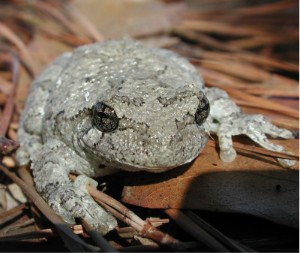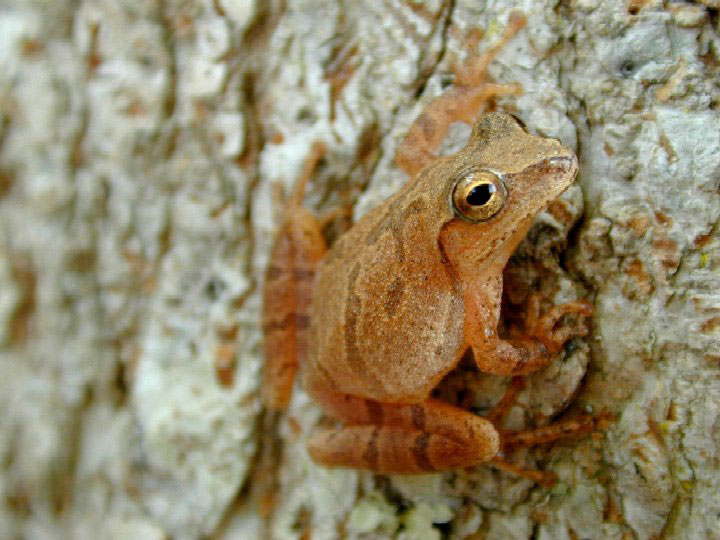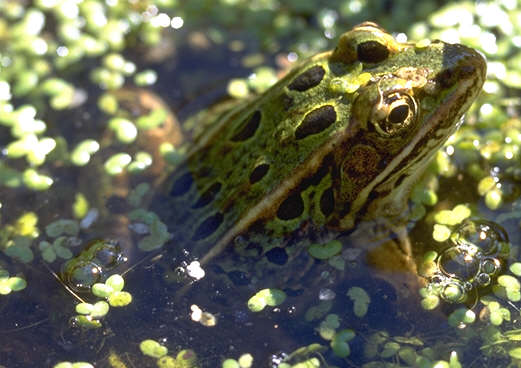AY Honors/Amphibians/Answer Key
1. What are the characteristics of amphibians?
Amphibians live half of their lives in water and half on land. They are cold-blooeded vertebrates. Amphibians are able to breathe through their skin, making them very sensitive to anything they come in contact with, including human hands. When observing amphibians, one should never touch them.
2. Name the two main orders of amphibia and tell how to distinguish between them.
- Order Anura (frogs and toads)
- Adult frogs and toads are characterized by long hind legs, a short body, webbed digits, protruding eyes and the absence of a tail. Most have a semi-aquatic lifestyle, but move easily on land by jumping or climbing. They typically lay their eggs in puddles, ponds or lakes; and their larvae, called tadpoles, have gills and develop in water.
- Order Caudata (newts and salamanders)
- Cuadata have slender bodies, short legs, and long tails. The moist skin of the amphibians fits them to habitats either near water or under some protection on moist ground, usually in a forest. Some species are aquatic throughout life, some take to the water intermittently, and some are entirely terrestrial as adults. Salamanders superficially resemble lizards, but are easily distinguished by their lack of scales. They are capable of regenerating lost limbs.
3. Distinguish between toads and frogs.
The use of the common names "frog" and "toad" has no taxonomic justification. From a taxonomic perspective, all members of the order Anura are frogs, but only members of the family Bufonidae are considered "true toads". The use of the term "frog" in common names usually refers to species that are aquatic or semi-aquatic with smooth or moist skins, and the term "toad" generally refers to species that tend to be terrestrial with dry, warty skin. An exception is the Fire-bellied toad (Bombina bombina): while its skin is slightly warty, it prefers a watery habitat.
4. How do amphibians protect themselves?
The first line of defense for amphibians is to not be seen by a potential predator. The small size and coloration of many species help in this regard, but sometimes, rather than blending in, frogs are very brightly colored. The coloration in this case serves as a warning, for these frogs are poisonous.
Many frogs contain mild toxins that make them distasteful to potential predators. For example, all toads have large poison glands—the parotid glands—located behind the eyes on the top of the head. Some frogs, such as some poison dart frogs, are especially toxic.
Salamanders have the ability to detach their tails at will. When a predator captures a salamander by the tail, the salamander detaches its tail and escapes. The tail regenerates or grows back.
5. Make a list of amphibians that should be found in your locality. Identify five and tell where you found them. OR Collect pictures or sketch five different amphibians which you can identify and tell where they are found.
The gray tree frog, spring peepers, wood frogs, marsupial frogs, and leopard frog are all found in New York.
Grey Tree Frog (Hyla versicolor)
Where found: Grey tree frogs inhabit a wide range, and can be found in most of the eastern half of the United States, as far west as central Texas. They also range into Canada in the provinces of Ontario and Manitoba, with an isolated population in New Brunswick.
Description: Grey tree frogs live primarily in trees, spending time in wooded areas, usually not far from a permanent water source. On rainy evenings they can often be found calling in or near shallow, temporary pools of water. They are nocturnal and insectivorous, consuming most any small arthropod they can catch. Mating occurs throughout the spring and summer months.
Spring Peeper (Hyla crucifer)
Where found: There are two subspecies of the spring peeper, the northern (P. c. crucifer) and the southern spring peeper (P. c. bartramiana). The northern is similar to the southern except for a strong dark marking on the southern frog's belly. The southern spring peeper is limited to northern Florida and southern Georgia, while the northern can be found all over the east of the USA and eastern Canada.
Description: The spring peeper is a small frog, attaining an adult size between 0.75 and 1.5 inches (up to 40mm) long. They have a dark cross on their backs roughly in the shape of an "X", though sometimes the marking may be indistinct. The color variations of the spring peeper are mostly tan, brown, olive green, or gray. Females are lighter-colored, while males are slightly smaller and usually have dark throats. Spring peepers are nocturnal frogs, so they are mostly heard but not seen. And they are especially easy to hear due to their extremely loud mating call which gives them the name "peeper".
Wood Frog (Lithobates sylvaticus)
Where found: Wood Frogs are found from northern Georgia and in isolated colonies in the central highlands in the eastern to central parts of Alabama, up through the northeastern United States, and all the way across Canada into Alaska. It is the most widely distributed frog in Alaska. They can be found from southeastern Alaska to north of the Brooks Range.
Description: Wood Frog is the common name given to Lithobates sylvaticus[1][2], previously Rana sylvatica. They are the only frogs found north of the Arctic Circle. In winter, as much as 35-45% of the frog's body may freeze, and turn to ice. Ice crystals form beneath the skin and become interspersed among the body's skeletal muscles. During the freeze the frog's breathing, blood flow, and heart beat cease. Freezing is made possible by specialized proteins, glucose and perhaps accumulation of urea, which prevent intracellular freezing and dehydration. Wood Frogs primarily breed in ephemeral pools rather than permanent water bodies such as ponds or lakes. Adults emerge from hibernation in early spring and migrate to nearby pools. There, males chorus (a quacking sound) and mating occurs. Adult Wood Frogs spend summer months in moist woodlands, forested swamps, and bogs where they forage and maintain body moisture as surrounding evironments dry out. Females' eggs are formed by late fall. By late fall or early winter, they leave forested swamps and travel to neighboring uplands to overwinter. Some may remain in moist areas to overwinter. They tend to hibernate in the upper organic layers of the soil, under leaf litter, and in close proximity to breeding pools.
Leopard Frog (Rana)
Where found: Once abundant in North America and Canada, their population has declined in recent years because of pollution and deforestation. Leopard frogs are often used as environmental indicator species because of their heightened sensitivity to chemical pollutants found in the air and water.
Description: Leopard frogs, which are also called meadow frogs and grass frogs, are a collection of so-called true frog within the genus Rana. They are commonly used as dissection specimens in biology classrooms. Leopard frogs are recognized by their green or brown coloration with distinct light-edged dark spots across the back and white underside. They also have a characteristic line of raised glandular skin extending from each eye to the groin.
Australian Green Tree Frog (Litoria caerulea)
Where found: The Australian Green Tree Frog, simply Green Tree Frog in Australia, White's Tree Frog, or Dumpy Tree Frog (Litoria caerulea) is a species of tree frog native to Australia and New Guinea, with introduced populations in New Zealand and the United States.
Description: The Green Tree Frog can grow up to 10 centimetres (4 inches) in length. Its colour depends on the temperature and colour of the environment, ranging from brown to green; the ventral surface is white. The frog occasionally has small, white, irregularly shaped spots on its back, up to five millimetres in diameter, which increase in number with age.
6. Describe the life history of some amphibian.
Adventist Youth Honors Answer Book/Nature/Life cycle of a frog
7. Explain the economic value of amphibians.
Amphibians are insect eaters, so they are very valuable for controlling mosquito populations. They are also the preferred dinner for several mammal, bird, fish, and reptile species.
Amphibians are valuable for medical research. They are raised and sold to research institutions.
The larvae of newts and salamanders are sold as fish bait.
Amphibians are closely monitored by ecologists, because they are among the first animals affected by environmental problems such as pollution and the destruction of the ozonelayer.
8. Where do toads spend the winter or dry season?
Toads burrow below the frost line and hibernate for the winter. Plant matter actually generates a bit of heat as it decays, so toads prefer areas with plenty of leaf litter and fallen logs.
9. Identify two species of frogs by their sound or imitate the sounds of two different species of frogs.
Smithsonian Folkways Recordings has several frog calls available on CD or for download.
10. How do frogs and toads sing? What makes the noise so loud?
Frogs call by passing air through the larynx in the throat. In most calling frogs, the sound is amplified by one or more vocal sacs, membranes of skin under the throat or on the corner of the mouth that bulge out during the amplification of the call.
Some frogs lack vocal sacs, but these species can still produce a loud call. Their mouths are enlarged and dome-shaped, acting as a resonance chamber that amplifies their call. The body of a guitar does much the same thing, having a large hollow section that causes the sound to resonate inside before escaping to the outside atmosphere.
11. Do one of the following:
- IMPORTANT
- In the 1990's, amphibian populations in the United States and Canada began a precipitous and mysterious decline. Many frogs were discovered in Minnesota with unexplained deformities, including extra limbs, missing limbs, deformed limbs, and missing eyes. As a result, many species of amphibians are now protected by state and federal laws. When observing wild amphibians, it is extremely important that they not be handled. Doing so can spread disease to these creatures, causing further decline. Before venturing out, make sure your Pathfinders understand and appreciate the danger facing amphibians today. Do not allow your group to capture or otherwise harass them, and do not destroy their environment. Rather than pursuing the two options (a and b) listed for this requirement, it may be wiser to substitute an alternate requirement. One possibility is to have your Pathfinders research the amphibian population crash.
a. Observe a toad in your yard or neighborhood to find out.
(1) Where and when it sleeps,
(2) When it leaves its home for food,
(3) How fast it can travel,
(4) How far it can jump, and as many other interesting things as you can find out about it, and write an essay covering the details requested in the first section of this question.
It is recommended that instead of investigating wild amphibians, the student should research them using other available resources, including the Internet, books, and encyclopedias. It is recognized that observing them in the wild is by far more fascinating, but it also carries the potential to do great harm to the amphibian population. See the notes in section b for more details.
b. Hatch some amphibian eggs and watch them through their growth cycle and write an essay covering the details.
Frog eggs can be purchased from http://www.nilesbio.com/subcat367.html - but only in the spring.
According to Field Guide of Amphibian Larvae and Eggs of Minnesota, Wisconsin, and Iowa, a publication of the U.S. Geological Survey (USGS), "State and federal laws protect amphibians from exploitation. Collection permits are required from the appropriate state or federal authorities before capturing, handling, or collecting amphibians."
It is therefore recommended that you not attempt to collect amphibian eggs on your own. You can download this book as a PDF from the page cited above. Even if you do not live in Minnesota, Wisconsin, or Iowa, the species covered in this book may be indigenous to your area.
The USGS publication further states, "To prevent the spread of disease to native populations, any frogs or salamanders you raise should not be released back into the environment. Lab-raised amphibians can be anesthetized and euthanized with benzocaine or tricaine methanesulfonate (MS 222, Green 2001). If you anticipate difficulty complying with this guidance, you should not undertake raising larvae in captivity."





